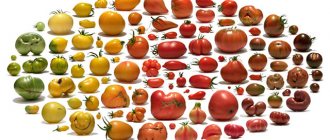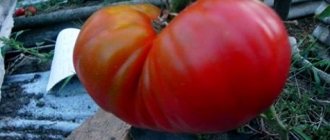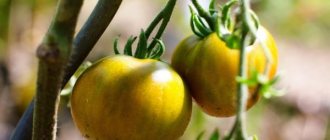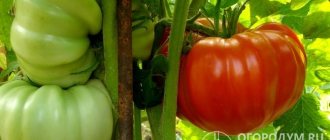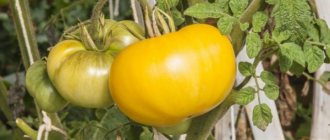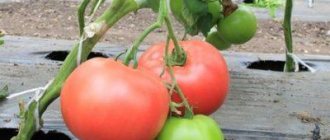The Spanish giant tomato will be the pride of any gardener. Its fruits are so large that a single tomato is enough for a salad for the whole family. In addition, it has a wonderful taste and high yield.
| Height | Landing location | Ripening time | Fruit color | Fruit size | Origin | Fruit shape |
| short | Greenhouse | Mid-season | Reds | Large | Variety | Plum-shaped or oval |
Tomato Spanish giant - description and characteristics of the variety
Amen lovers of growing vegetable crops of the Solanaceae family give preference to varieties with high yields and excellent taste.
One of these species is the Spanish Giant tomato variety. This heat-loving plant does not tolerate sudden changes in temperature, which is why experts recommend growing it in areas with a temperate climate and in greenhouses. Eggs are a universal crop. They are used for preparing first and second courses, eaten in salads and used for winter preparations.
Description of the variety
- The height of the bushes can reach from two to three meters. This fact presupposes the obligatory tying of plants during development and growth.
- Approximately 10-11 ovaries are formed on one bush.
- The fruits are more than large and fleshy.
The average weight of one tomato is 350 grams. With proper and high-quality care, the weight can reach 500 grams. - The tomato pattern is oval with an elongated tip.
- After ripening, the fruits acquire a slightly red tint.
- The skin is dense and not prone to cracks, so the fruits can be stored fresh for a long time and transported over long distances.
Preparing for landing
Like most tomatoes of different types, this variety is planted in seedlings. The yield and taste of tomatoes depends on the quality of grown seedlings. The first step is to prepare the seeds and soil for sowing. Seeds are purchased in specialized stores.
You can start sowing at the end of February. Before sowing, the starting material should be treated with soda or manganese solution. To please anyone, the seeds are placed in the solution for 2-3 hours. Disinfection occurs so much that it will have a positive effect on the future harvest.
If the soil for sowing is taken from a personal plot, then it should be properly processed. To do this, you need to pour boiled water into a container with soil, or perhaps a weak solution of potassium permanganate. You can calcine the soil in the oven for 2-3 hours.
Such measures will help remove all harmful insects and protect against dangerous viruses and fungi. After this, organic amendments need to be pressed into the soil. Wood salicor, peat and river sand are well suited for tomatoes.
After all the preparatory manipulations, you can only start sowing.
How to grow the Spanish giant variety
- Movras are planted to a depth of 2 cm. The top of the boxes or containers are covered with cellophane or other suitable material. For faster germination, it is necessary to ensure the supply of sunlight, heat and regular watering. If all requirements are met, the first shoots will appear in 3-4 days.
- (otherwise the planting took place in a disorderly manner, and there is a large crowding of seedlings, it is necessary to carry out picking. The grain is planted in separate pots or glasses for further development.
- After about 50-55 days (God) ordered planting to begin in the greenhouse.
The Spanish Giant variety is very sensitive to unfavorable climatic conditions, therefore, for the healthy development of plants, it is necessary to provide appropriate fob.
Planting in a greenhouse and care
The soil in the greenhouse should be prepared ahead of time. Starting in the fall, it is necessary to fertilize it with humus. To prevent fungal infection, you need to sprinkle ash or lime onto the surface.
It is better to carry out planting in warm and calm weather. The seedlings are planted in prepared holes at a distance of 70-80 cm from each other. Next to each bush you need to identify a wooden stick or metal rod where you need to untie the bushes as they grow.
In order to obtain a richer harvest of healthy and tasty fruits, it is necessary to follow the rules of care.
- The formation of bushes has a huge function for obtaining larger tomatoes. You can leave Vodan - two shoots and one strong stepson, the rest needs to be removed. No more than eight raceme inflorescences should develop on one bush.
- To stop the growth of the plant, the top must be pinched after the last ovary has formed.
- It is imperative to ventilate the greenhouse regularly, try to do this in warm weather.
- Plants should be doused as needed. Tomatoes do not like drought, and excess moisture can lead to negative consequences.
Spanish giant tomatoes are popular among gardeners. The fruits are juicy and fleshy, excellent for fresh consumption. From one large fruit you can make a summer salad for the whole family. If you follow all the care requirements, you will always be satisfied with the resulting harvest.
Preparing for landing
Like most tomatoes of different types, this variety is planted in seedlings. The yield and taste of tomatoes depends on the quality of grown seedlings. The first step is to prepare the seeds and soil for sowing. Seeds are purchased in specialized stores. You can start sowing at the end of February. Before sowing, the starting material should be treated with soda or manganese solution. To please anyone, the seeds are placed in the solution for 2-3 hours. Disinfection occurs so much that it will have a positive effect on the future harvest.
If the soil for sowing is taken from a personal plot, then it should be properly processed. To do this, you need to pour boiled water into a container with soil, or perhaps a weak solution of potassium permanganate. You can calcine the soil in the oven for 2-3 hours. Such measures will help remove all harmful insects and protect against dangerous viruses and fungi. After this, organic amendments need to be pressed into the soil. Wood salicor, peat and river sand are well suited for tomatoes. After all the preparatory manipulations, you can only start sowing.
Planting in a greenhouse
Prepared greenhouses are supplied with healthy soil, which must be disinfected. The earth is poured in a layer of seventeen centimeters on layers of manure. To prevent the appearance of pathogenic fungi, the manure should be powdered with wood ash or lime fluff. Tomatoes love nutritious soil with high permeability to water and air. The universal composition will be a mixture of chernozem and peat.
Seedlings should be planted in a greenhouse on a windless day, in the evening. The tomato stems are well buried.
Tall Spanish giant tomatoes need proper care. Its description includes:
- Bush formation. You can leave one stem or two. Then, in addition to the main shoot, a powerful stepson is needed under the first flower cluster.
- It is better to leave up to seven or eight flower clusters on tomatoes.
- After the clusters have formed, the top of the main stem is pinched.
- Tall tomatoes require a mandatory garter.
- In addition to moderate watering, to preserve moisture, mulch the soil with a layer of straw and peat.
- Greenhouses are ventilated by monitoring the air temperature. It should not rise above 29 degrees Celsius.
- Fertilizers use both organic matter and minerals every ten days.
Giant fruits should be collected as they ripen. Brown, placed in a dry and warm room for ripening.
According to reviews from vegetable growers, the Spanish Giant variety is distinguished by its rapid ripening. I like tomatoes for their excellent taste and meaty fruit. They are instantly eaten by children and adults in the summer.
How to grow tomatoes
A heat-loving tomato plant, prefers areas with a hot climate. There are all conditions for rapid development and high yields. The rays of the sun, warm wind, and soft rain help the fruits to ripen quickly. In temperate climates, such varieties, giants, are best planted in seedlings.
Preparing seedlings
Vegetable growers know that the future tomato harvest largely depends on the seedlings and their quality. Almost everything has to do with when the tomatoes were sown and how they were cared for.
If in the southern regions you can sow a vegetable plant at the end of February, then in a temperate climate - in mid-March. You can determine the timing yourself if you count 55-65 days from the end of frost. Sowing of Spanish Giant tomatoes for the greenhouse begins two weeks earlier.
See also
Description and characteristics of the tomato variety Kapiya pinkRead
To create tomato seedlings, the following conditions are necessary:
- a lot of light;
- high humidity;
- air temperature from 18 to 25 degrees above zero.
Preparation for sowing tomatoes plays an important role. It includes disinfection of seeds and soil. The seed material goes through the stage of treatment with a solution of potassium permanganate for twenty minutes, baking soda (0.5 grams per half glass of water). It helps to keep the seeds healthy by placing them in liquid Fitosporin for two hours.
The soil is calcined in the oven for ten minutes, maintaining a temperature of two hundred degrees. You can spill the soil with boiling water or a solution of potassium permanganate. Disinfection methods are combined or chosen the most suitable for yourself.
Ten days after the procedures, they begin to plant the seeds. They are sealed to a depth of one centimeter. The distance between seedlings should not be small, otherwise the seedlings will not have enough nutrients.
Boxes with seedlings are placed in a warm place, covered with film, and often moistened. Usually after three to four days the plants begin to hatch. Sprouts require care in the form of:
- regular watering;
- backlight 16 hours a day;
- ventilation;
- heat;
- sunbathing;
- feeding every three weeks.
If the plantings are crowded, as soon as two or three true leaves appear, seedlings begin to pick.
The signal for transferring tomatoes to the greenhouse is the laying of the first flower clusters. Ten days later, the seedlings are planted in closed ground.
Description of the variety
The height of an individual tomato bush can reach 180 cm, but the fragile stem is clearly not designed for such growth, so tying up the plant as it grows is necessary. The ovaries, which begin to form on the hand immediately after the release of the 9th permanent leaf, appear approximately 115 days from the moment the seedling is planted, which indicates the early ripening of the variety.
Ripe tomatoes fully justify their name - the average fruit weighs about 0.5 kg, and the most pronounced ones, located in the lower part of the bush, quietly ripen to a weight of 0.8 - 1 kg. However, the yield is determined not so much by the quality and weight of an individual tomato, but by the number of ovaries. The brushes are located quite densely throughout the bush - every 3-4 leaves. They even give a figure indicating the yield from one bush - up to 8 kg of fruit, but reviews from most gardeners suggest that this value is overestimated.
The characteristics of the fruit are impressive - tomatoes, when fully ripe, become red in color, their shape is flattened at the stalk and below. The taste is sweetish, with unexpressed sourness, and when overripe, sugary. The fruits have a very characteristic, rich pulp, divided into 6-8 chambers.
The main advantages of the variety are:
- high content of vitamins;
- immunity to many common diseases;
- high productivity;
- good keeping quality of picked fruits.
Among the disadvantages, one can note the whimsical nature of seedlings before planting them in the ground, the constant need to feed seedlings and tie up growing bushes.
There is one more feature, noticed by those who have been growing this variety of tomato for many years - it is better to pick the fruits a little unripe, or not to miss the moment when the tomato comes into full flavor and immediately remove it from the bush. Once overripe, King of the Giants tomatoes quickly lose their appearance and burst. Most often this cannot be avoided due to excessive watering.
The most popular tomato varieties among giants
Large-fruited tomatoes today are represented by a wide variety of varieties with vegetables of various shapes and colors. Varieties and their hybrids have also been bred for cultivation in any climatic zone.
Tomato Raspberry Giant
The early-ripening determinate tomato variety “Crimson Giant” was bred by a group of breeders led by Lukyanenko and entered into the State Register in 2007. Characteristics:- full ripening occurs after 100 - 110 days;
- yield from 6 to 8 kg per 1 sq.m; average susceptibility to the most common diseases;
- low shelf life and transportability.
| It is grown in all regions of the Russian Federation in carbonate and film greenhouses, and in the southern regions in open ground. |
A non-standard branched bush with a height of 0.7 to 1.5 meters requires mandatory formation and pinching. A well-formed root system grows laterally in the upper layers of the soil.
Large leaves of a dark green color with slight wrinkles have a regular shape.
Inflorescences of the intermediate type are placed every 2 leaves, starting from the first 5-6 leaves. Typically, up to 4 fruits are formed on each inflorescence, with at least 1 being quite large. Tomatoes that hold tightly to the stalk are not susceptible to shedding.
The fruits of the “Crimson Giant” have an irregular flat-round shape with a diameter of about 10 cm. There is a slight ribbing from the stalk. When ripe they have a pink tint, the stalk is surrounded by a greenish spot. The ripe fruit is a rich crimson color. The weight of a tomato is usually 200 - 400 g, and on the lower inflorescence it can reach up to 1 kg.
The pulp is tender, fleshy, with a small number of grains, tastes sweet with the presence
slight sourness. It is eaten both fresh, in salads, and for making juices, pastes and ketchups. Self-harvesting of seeds is possible.
Tomato King of the Giants
Bred in 2010 by Siberian breeders. Tomatoes “King of Giants” are indeterminate varieties with an average ripening period.
Developed for cultivation in open ground in the southern regions and in greenhouses in the middle and northern regions.
Characteristics:
- ripening period 110 - 120 days;
- yield from 7 to 9 kg per sq.m;
- low susceptible to pests and diseases;
- easy to care for;
- good keeping quality and transportability.
Bushes 1.7 - 2 m high require constant pinching and gartering. The best yield results are achieved when forming a bush of 1-2 stems.
The first ovary appears after the 9th leaf, the rest after 3-4 leaves
The round, slightly flattened, bright red fruits reach a weight of 400 - 600 g, but specimens weighing up to 800 - 1000 g are not uncommon. The skin is dense and not susceptible to cracking. The fleshy and juicy pulp has a sweet taste with barely pronounced sourness, and when overripe, even sugary.
This variety is distinguished by its high content of vitamins and is recommended for preparing children's and dietary dishes.
Tomato Sugar Giant
The Sugar Giant is undemanding in care, is resistant to weather changes and sets fruit well, regardless of the climate. The “Sugar Giant” tomato belongs to the indeterminate standard mid-early varieties. Brought out in 1999 by Russian breeders and entered into the State Register in 2000 as a variety for cultivation on open ground and in greenhouses.
Characteristics: ripening period 110 - 115 days;
- yield 15 - 18 kg per square meter. m;
- tolerance to temperature changes and lack of moisture;
- decent disease resistance.
A plant 1.2 - 1.5 m high with a strong stem requires garter with supports and pinching.
The first ovary is formed above the 9th leaf, the rest after 2-3 leaves. Tomatoes are pink-red and have a round, slightly elongated shape. The weight of a ripe tomato is 350 - 450 g. Specimens weighing up to 800 g are not uncommon.
The juicy pulp with a sweet taste has a high content of sugars and lycopene. Suitable for fresh consumption and for making juices and sauces.
Tomato Giant red
The “Giant Red” tomato was bred by amateur breeders in 1989 and entered into the State Register as a plant for greenhouses and open ground. The mid-early tomato variety is an indeterminate standard species.
Characteristics:
- ripening period 100 - 105 days;
- yield up to 12 kg per square meter. m;
- resistance to the most common diseases;
- tolerance to lack of moisture;
- poor keeping quality;
- pickiness about soil composition.
In the southern and middle regions it is grown in open ground, in the northern regions - in greenhouses.
A bush with long drooping leaves 140 - 180 cm high requires mandatory formation and pinching. The trunk must be tied up, and supports are required under the branches. The first ovary is formed after the 10th leaf, the rest after 3 leaves. The cluster is simple, 5-6 fruits each.
Large, slightly flattened, rounded fruits with slight slight ribbing acquire a bright red color when ripe. The weight of a tomato is 450 - 650 g, and on the lower clusters it can reach 700 - 850 g. The pulp, saturated with juice, has excellent taste and a high content of provitamin A and sugars.
Suitable for fresh consumption and for making juices, sauces and ketchups.
Tomato Angela – Giant
The “Angela - Giant” tomato is included in the assortment of collectors of Russian gardeners and belongs to the indeterminate mid-season varieties. Bred for cultivation in greenhouses, closed ground and film coverings.
Characteristics:
- ripening period 100 - 130 days;
- yield 8 - 10 kg per square meter. m;
- unpretentiousness;
- high resistance to diseases;
- good keeping quality.
A plant with a height of 1.4 - 2 m must be formed and subsequently planted. The trunk must be tied up and supports placed under the branches.
| To grow especially large fruits, 1 trunk is formed and the number of ovaries is regulated. |
The fruits are flat-round, medium ribbed, and have a deep red color. Weight ranges from 300 to 1000 g, and if desired, specimens of 1.5 - 2 kg can be grown. The fleshy, sweetish-tasting pulp with a small amount of seeds is suitable for salads, sauces and baby purees.
Tomato Giant Novikova
The variety “Giant Novikova” was registered in the register in 1990 as a mid-season tomato for cultivation in film greenhouses. Plant of indeterminate standard type with regular foliage.
Characteristics:
- ripening 110 - 120 days;
- yield 15 - 20 kg per sq.m;
- average resistance to diseases;
- average keeping quality;
- pickiness about soil composition.
To grow large fruits and a good harvest, the bush should be formed into 1 stem with a mandatory vertical garter and stepsoned in a timely manner. The author of the variety, A.I. Novikov himself, collected up to 30 kg from one bush.
| The flat-round, strongly ribbed fruits are pink with a raspberry tint. They usually weigh 500 - 600 grams, but kilogram specimens are not uncommon. |
The juicy, sugary pulp is great for making juices and sauces, and the sweet tomato itself is excellent fresh and in salads.
Tomato Spanish Giant
The “Spanish Giant” tomato belongs to the mid-late indeterminate varieties and is recommended for cultivation in open ground and in greenhouses.
Characteristics:
- maturity 110 - 120 days;
- yield 10 - 12 kg per square meter. m;
- thermophilicity;
- average resistance to diseases;
- pickiness to temperature changes;
- excellent keeping quality and transportability.
A bush 2 - 3 meters high needs shaping, vertical garter, pinching the top and pinching. The average weight of the red oval fruits is 250 - 350 g. The juicy pulp with a considerable amount of dry matter has an excellent taste.
| Tomatoes are consumed fresh and in salads. |
Tomato Leningradsky Giant
The Leningrad Giant tomato is an early-ripening variety for film greenhouses. A determinate plant with large carved leaves reaches a size of 80 - 95 cm.
Characteristics:
- maturation 85 - 90 days;
- yield 8 - 12 kg per square meter. m;
- average resistance to diseases;
- thermophilicity.
| The first simple inflorescence is formed above the 7th leaf, then after 1 - 2 leaves. The flat-rounded fruit with slight ribbing has a pink color when ripe. |
The sugary, juicy pulp has a rich dessert taste. They are consumed fresh, in salads and used to make sauces, ketchups, pastes and desserts.
Tomato Yellow Giant
The mid-season tomato variety “Yellow Giant” was bred by breeders. The indeterminate plant can grow in open ground and in greenhouses.
Characteristics:
- ripening 110 - 122 days;
- yield up to 15 kg per sq. m;
- recommended for allergy sufferers and baby food;
- bears fruit for 1.5 months;
- poor keeping quality.
Bushes 1.2 - 1.7 m high need shaping, staking and pinching. The fruits are flat, round and yellow in color, reaching a weight of 300 - 400 g.
The pulp, rich in juice, sweetish in taste, with a high content of niacin, is useful for heart patients and people with liver disease.
Tomato Ural Giant
The “Ural Giant” tomato belongs to the mid-season type and is represented by a series of four identical varieties, differing in the color of the fruit. Successful adaptation to the climate of various regions from the south to the north has brought the “Ural Giant” well-deserved popularity among gardeners.
Characteristics:
- maturity 110 - 120 days;
- yield 10 - 15 kg per square meter. m;
- excellent adaptation to weather conditions;
- poor keeping quality.
An indeterminate type bush with a height of 1.5 - 1.8 m requires mandatory shaping, vertical staking and support of branches, topping and pinching.
The fruits are rounded and flattened with slight ribbing. The weight of a tomato is 700 - 800 g, but specimens can be grown up to 1.5 kg. The pulp at the break is granular-sugar, juicy, sweet in taste.
| The red variety stands out among others due to its high lycopene content. The pink tomato has a unique sweetness. Yellow (lemon) and orange varieties are rich in carotene and have a rich, piquant taste. |
Description of the Spanish giant tomato, cultivation and planting rules
The Spanish giant tomato is popular among summer residents and gardeners, since the fruits of this variety are very large and the yield is high. The tomato is medium late, 1 tomato weighs 350 g or more.
What is a Spanish giant tomato?
Below is a description of the variety:
- The plant reaches a height of 2-3 m.
- About 10 large fruits grow on 1 bush.
- The average weight of 1 tomato is 350-500 g.
- The productivity of the variety is very high. One plant gives a yield of 5-7 kg.
- The shape of the fruit is round, slightly elongated, reminiscent of a plum.
- The color of the tomatoes is red. The pulp of the fruit is juicy. The dry matter content in the pulp is high, there are few seeds.
- The fruits are used fresh for preparing salads, various dishes, juices, tomato puree, pastes, sauces, and gravies.
How to grow tomatoes?
The giant tomato is bred in a greenhouse because it cannot stand the cold. In regions with warm climates, they can also be planted in open ground. The plant should be grown in a sunny area, where it will be protected from gusty winds and heavy rainfall. If the climate of the region does not allow planting Spanish giant tomatoes in open ground, they are cultivated in greenhouses, under film, in shelters and greenhouses.
Tomatoes are grown in seedlings. The yield depends on the quality of the seedlings, so you need to follow the rules for caring for this variety. In the southern regions, tomatoes are sown at the end of February, in the middle zone - in mid-March. To determine the time for sowing seeds in your region, you need to count about 55 days from the end of frost. You can sow Spanish giant tomatoes in a greenhouse 2 weeks earlier.
Seedlings need a lot of light and the soil must be moist. Sprouts sprout well at air temperatures of +18…+25 ºC. Before sowing seeds, it is necessary to disinfect the soil and seeds; to do this, the latter are treated with a weak solution of potassium permanganate for 20 minutes.
You can also treat the planting material with a soda solution. You need to take 0.5 g of baking soda and mix with 0.5 cups of water. You can place the planting material in the Fitosporin solution for 2 hours. This also increases the plant’s resistance to various diseases.
The soil is prepared as follows. The soil must be calcined in the oven at a temperature of +200 ºC. You can also treat the soil with boiling water or a solution of potassium permanganate. 10 days after such preparation, the seeds are sown. They should be sown in holes 1 cm deep. The distances between the holes should be small. After this, the container with the seedlings must be placed in a warm room and covered with cellophane.
The soil should be kept moist all the time; for this it is watered regularly. The first shoots appear 3-4 days after sowing. Seedlings need to be watered and provided with lighting 16 hours a day. There must be fresh air in the room. Feed once every 3 weeks. After the formation of 2-3 leaves, the seedlings are picked. After the formation of inflorescences, the plant is transferred to the greenhouse.
Before planting, the soil is disinfected. To do this, the soil is poured in a layer of 17 cm on top of a layer of manure. First you need to mix manure with wood ash. The best soil for growing Spanish giant tomatoes is a mixture of peat and black soil. Planting is carried out in warm weather, when there is no wind. The seedlings must be thoroughly buried.
The soil is mulched with peat and straw. The greenhouse must be regularly ventilated so that the air temperature is +25 ºC. Every 10 days, plants should be fed with organic and mineral fertilizers. As the fruits ripen, they are harvested.
How to grow the Spanish giant variety
- Movras are planted to a depth of 2 cm. The top of the boxes or containers are covered with cellophane or other suitable material. For faster germination, it is necessary to ensure the supply of sunlight, heat and regular watering. If all requirements are met, the first shoots will appear in 3-4 days.
- (otherwise the planting took place in a disorderly manner, and there is a large crowding of seedlings, it is necessary to carry out picking. The grain is planted in separate pots or glasses for further development.
- After about 50-55 days (God) ordered planting to begin in the greenhouse. The Spanish Giant variety is very sensitive to unfavorable climatic conditions, therefore, for the healthy development of plants, it is necessary to provide appropriate fob.
Delicious fat tomato “Giant Red”: description of the variety, photo
Those who love large red tomatoes will definitely be interested in the “Red Giant” variety.
This is a medium-yielding variety, but its fruits have very high taste, and the bush itself is highly resistant to disease. Read more in our article.
- Red giant tomato variety description
Country of origin and year of registration In which regions is it best to grow Method of use What is the yield of the variety
Photo Advantages and disadvantages Features of the variety and its cultivation Diseases and pests Useful video
This is a mid-early variety; from the moment you plant the seedlings until the fruits fully ripen, 100-105 days will pass. The plant is of an indeterminate, standard type.
It grows equally well both in unprotected soil and in greenhouse shelters. The plant is quite tall, 140-180 cm. It has complex resistance to diseases.
The tomatoes, once fully ripe, are bright red in color. Round in shape, slightly flattened.
Very large 450-650 g, the fruits of the first harvest can reach 700-850 g. The number of chambers is 6-8, the dry matter content is about 5%. The collected fruits are not stored for very long; it is better not to keep them for a long time, but to process them or eat them fresh.
Country of origin and year of registration
“Red Giant” was bred long ago in the USSR through amateur selection; it received registration as a variety for greenhouses and open ground in 1989.
Since then, it has been a favorite among gardeners due to its high varietal qualities. With such properties, he will remain among the leaders for a long time.
Which regions are best to grow in?
Tomatoes of this variety are best grown in the southern regions if done in open ground. Under film it gives good results in the middle band. This does not significantly affect the yield and morbidity of the plant.
In more northern regions, these tomatoes are cultivated only in heated greenhouses.
Method of use
These tomatoes are not suitable for whole-fruit canning due to the large size of the fruits, but you can make barrel pickles. Red giant tomatoes are very good fresh. Juices, purees and pastes are very good due to the high content of sugars and vitamins.
What is the yield of the variety
Although this variety is a “giant”, its yield is very modest. Under good conditions, you can collect 3-4 kg from each bush.
With a recommended planting density of 3 plants per square meter. m comes out to 12 kg. This is far from a record, especially for such a tall bush.
The photo shows the Red Giant tomato
Advantages and disadvantages
Among the main positive qualities of the “Red Giant” variety are:
- high taste qualities;
- large fruit;
- immunity to diseases;
- tolerance to lack of moisture.
Among the disadvantages, one should highlight not the highest yield and capriciousness to the composition of the soil.
Features of the variety and its cultivation
The main feature of the “Red Giant” species is its large fruit. Also, many note the high resistance to diseases and the high taste of the fruit.
The trunk of the bush must be tied up, and the branches must be strengthened with supports; this will save the plant from breaking off the branches. It should be formed into two or three stems, usually three in open ground. It responds very well to complex feeding at all stages of growth.
Diseases and pests
This variety has complex resistance to fungal diseases.
The only thing to be wary of is diseases associated with improper care. To avoid such difficulties when growing, you need to regularly ventilate the room where your tomatoes grow and follow the watering and lighting regime
You should also pay attention to the composition of the soil; it should not be acidic
Neutral soils are best. These measures will help to avoid problems when growing this variety.
Among the harmful insects it can be affected by melon aphids and thrips, the drug “Zubr” is successfully used against them. In the southern regions, the Colorado potato beetle can harm this species, especially in the southern regions; the “Prestige” product is successfully used against it.
Among the pests that are most capable of causing harm in greenhouses are melon aphids and spider mites; the drug “Bison” is also used against them. Like many other types of tomatoes, they can be attacked by the greenhouse whitefly; they fight it with the help of the drug “Confidor”.
As follows from the brief review, this is a variety for gardeners with some experience; it will be difficult for beginners. But don’t give up growing it on your plot, you will succeed. Good luck to you and have a delicious harvest.
Origin of giant tomato varieties
- 1 Origin of giant tomato varieties
- 2 Features of agricultural technology of giant tomatoes
- 3 The most popular tomato varieties among giants 3.1 Tomato Raspberry Giant
- 3.2 Tomato King of the Giants
- 3.3 Sugar Giant Tomato
- 3.4 Tomato Giant red
- 3.5 Tomato Angela - Giant
- 3.6 Tomato Giant Novikova
- 3.7 Tomato Spanish Giant
- 3.8 Tomato Leningradsky Giant
- 3.9 Tomato Yellow Giant
- 3.10 Tomato Ural Giant
When developing varieties of giant tomatoes, the main goal of breeders was to achieve larger sizes and improve the taste of the fruit. As a result, tomatoes with large fruits and an original sweet taste have been developed. The pulp of giant tomatoes is pleasant to the taste and contains an increased amount of sugars, lycopene and provitamin A. Perhaps the disadvantage of giant tomatoes can be considered the specificity of their use - for salads and processing into juice. They are not suitable for preservation due to their size; their shelf life is generally not great. The weight of the “giant” fruit usually ranges from 200 to 500 grams. And for growing in a garden or summer cottage - interesting, exciting and appetizing.
Spanish giant is the best among large-fruited varieties
Many farmers distinguish tomato varieties that produce fruits weighing five hundred grams or more. These include the mid-late Spanish giant. In addition to the large mass of the tomato, it is given the following characteristics:
- The height of the bush can reach from two to three meters.
- No more than ten to eleven fruits are borne on the stems.
- The average weight of a tomato reaches three hundred and fifty grams.
- The yield is high: from one bush you can collect five to seven kilograms of fruit.
- The shape of the tomatoes resembles a plum with an elongated spout and a soft red color.
- The juicy pulp contains a large percentage of dry matter and some seeds.
- The fruits are suitable for fresh consumption and vegetable cuttings.
Warmth is important for this variety; it does not tolerate temperature changes, so it is better to grow it in greenhouses
What is a Spanish giant tomato?
Below is a description of the variety:
- The plant reaches a height of 2-3 m.
- About 10 large fruits grow on 1 bush.
- The average weight of 1 tomato is 350-500 g.
- The productivity of the variety is very high. One plant gives a yield of 5-7 kg.
- The shape of the fruit is round, slightly elongated, reminiscent of a plum.
- The color of the tomatoes is red. The pulp of the fruit is juicy. The dry matter content in the pulp is high, there are few seeds.
- The fruits are used fresh for preparing salads, various dishes, juices, tomato puree, pastes, sauces, and gravies.
Features of planting and care
It is recommended to grow King of the Giants tomato seedlings yourself. It is advised to take seeds with a shelf life of no more than 2 years. It is advisable to purchase them from reliable suppliers, after making sure that they have been treated against harmful insects and fungal diseases.
Advice! If the treatment has not been carried out, it can be done at home using a weak solution of manganese.
Sowing King of the Giants tomato seeds for seedlings is carried out approximately 60–65 days before the plants are supposed to be planted in the ground or greenhouse.
The soil mixture can be used ready-made (in particular, black soil for indoor plants purchased at a gardening store or soil for seedlings). You can cook it yourself. To do this, it is recommended to mix fertile soil from the garden bed with river sand in a ratio of 2 to 1, heat it over a fire and add wood ash, ground into powder (0.5 kg for every 10 kg of mixture).
The prepared soil should be scattered into boxes and the seeds should be planted to a depth of 0.5 cm at a distance of 2–3 cm from each other. Next, they should be watered from a sprayer with water slightly warmer than room temperature, covered with film or glass and placed in a warm place (25–26 degrees) until shoots appear.
As soon as the seedlings begin to sprout, the temperature should be lowered (to about 18 degrees during the day and 16 at night) and place the containers with it in a well-lit place.
Important! At the initial stage, there is no need to water the seedlings. But the glass or film must be turned over or removed for a short time every day - this will make it possible to ventilate the seedlings and maintain optimal humidity.. When the plants have 3 independent leaves, the tomatoes should be picked and planted in separate pots
At this stage, watering (with warm water) is carried out as needed, making sure that the soil does not dry out
When the plants have 3 independent leaves, the tomatoes should be picked and planted in separate pots. At this stage, watering (with warm water) is carried out as needed, making sure that the soil does not dry out.
In the 3rd–4th decade of May, the bushes can be transferred to a greenhouse or open ground, making sure that frosts on the soil have already stopped.
Important! Before planting, the plants are “hardened”: within a week, the boxes are taken out onto the balcony or placed on an open window. Initially, this procedure is carried out for 30 minutes, then – an hour and a half, gradually increasing the time the seedlings remain in the air to 5 hours a day.. King of the Giants tomato plantings cannot be thickened: per 1 sq.m.
area should be planted no more than 2-3 bushes. Since this variety is large-fruited and tall, it is necessary to take care of additional growth of the root system by deepening the shoot into the ground when planting. After this, the plant should be thoroughly watered, mulched and hilled.
Planting of the King of Giants tomato cannot be thickened: per 1 sq.m. area should be planted no more than 2-3 bushes. Since this variety is large-fruited and tall, it is necessary to take care of additional growth of the root system by deepening the shoot into the ground when planting. After this, the plant should be thoroughly watered, mulched and hilled.
When planting, it is imperative to form a support system. As soon as the shoot grows, you need to tie it up immediately. In the future, you need to carefully monitor the plant and fix it at the support as soon as the need arises, so that the stem does not bend or break off under the weight of the tomatoes.
For successful growth, development and fruiting, the King of Giants tomato needs regular and abundant watering (ideally drip). It is recommended to regularly loosen the soil under the plants. It is also necessary to promptly remove stepsons located below the very first one (they leave it), without waiting for them to grow excessively.
Important! The soil under the tomato should be loosened after watering, while also removing weeds.
You also need to properly fertilize the soil, alternating minerals with organic substances. Tomatoes of this variety are fed for the first time 2–3 weeks after planting the seedlings in the ground. Next, nutritional compositions are added at the same intervals. The scheme could be as follows:
- the first feeding is an aqueous solution of ammonium nitrate (10 g per 10 l);
- the second - animal manure (1 kg) or chicken droppings (500 g), dissolved in 10 liters of water;
- the third is superphosphate (for 1 bucket of water - 30 g).
The norm for adding fertilizers according to this scheme is 500 ml for each plant.
Planting in a greenhouse and care
The soil in the greenhouse should be prepared in advance. Starting in the fall, it is necessary to fertilize it with humus. To prevent fungal infection, you need to sprinkle ash or lime on the surface.
It is better to plant in warm and calm weather. The seedlings are planted in prepared holes at a distance of 70-80 cm from each other. Next to each bush you need to install a wooden stick or a metal rod, where you need to tie the bushes as they grow.
In order to get a richer harvest of healthy and tasty fruits, you must follow the rules of care.
- The formation of bushes is of great importance for obtaining larger tomatoes. You can leave one or two shoots and one strong stepson, the rest must be removed. No more than eight raceme inflorescences should develop on one bush.
- To stop the growth of the plant, the top must be pinched after the last ovary has formed.
- The greenhouse should be ventilated regularly, try to do this in warm weather.
- Plants should be watered as needed. Tomatoes do not like drought, but excess moisture can lead to negative consequences.
Spanish giant tomatoes are popular among gardeners. The fruits are juicy and fleshy, great for fresh consumption. From one large fruit you can make a summer salad for the whole family. If you follow all care requirements, you will always be satisfied with the resulting harvest.
Description of the variety
The main distinctive features of the “Pink Giant” variety are:
- average ripening time: 110-115 days;
- fruit size: with proper care, the weight of one tomato can reach 1 kg;
- color - light red, pink;
- flat-round shape of the fruit;
- ribbing in the stalk area (increases as weight gains);
- resistance to many diseases and adverse conditions;
- juiciness and meatiness;
- potato leaf shape;
- deep green leaf color;
- simple inflorescence;
- formation of the first inflorescence above the 9th leaf, the second - every three;
- good keeping quality and transportability;
- do not require careful care or special knowledge and are ideal for beginners and those who are used to spending time wisely.
The main purpose
The fruits of the Pink Giant are large and quite fleshy, so they are well suited for fresh consumption, adding as an additional component to salads and main courses. Suitable for freezing and making pastes. These methods will help increase the concentration of vitamins several times. The variety is not suitable for preservation.
Productivity
The “Pink Giant” tomato variety is famous for its productivity. Favorable climatic conditions and compliance with growing rules will help you harvest up to 10 kg of tomatoes from one bush.
Degree of maturation
Despite the fact that the Pink Giant can please you with fruits within 100 days, do not rush to harvest ahead of time. Always focus on the color of the tomatoes: they should be deep pink or reddish in color. And they feel elastic to the touch. Unripe tomatoes taste less pleasant and their shelf life is shortened.
Advantages
- does not require special growing conditions;
- suitable for both open ground and greenhouses;
- sweetish taste, juiciness and sugar content of the fruit;
- in the southern regions of the country it can bear fruit until November.
Flaws
- the heaviness of bush branches and fruits;
- difficulties in tying: it is necessary to build sufficiently dense supports that can withstand the weight of the bushes;
- does not tolerate thickening;
- stepsoning required.
In which regions are Pink Giant tomatoes grown? In northern regions, where the average daily temperature drops below +19 degrees, it is better to grow this variety in greenhouse conditions. Otherwise, the bushes may freeze, and the amount of harvest will be reduced. In the southern regions, both open ground and a greenhouse are suitable.
Features of cultivation and storage
Since this variety is afraid of sudden changes in temperature, it is recommended to grow it in greenhouses, but in the southern regions open ground is also allowed.
The tomato is very tall, so after a sufficient number of clusters have formed, its top is pinched so that it spends nutrients on fruit ripening, and not on growth. In addition, pinching, maintaining 1-2 stems, and also tying to a vertical trellis is necessary.
To achieve good yield, it is better to leave 7-8 brushes on the bush.
